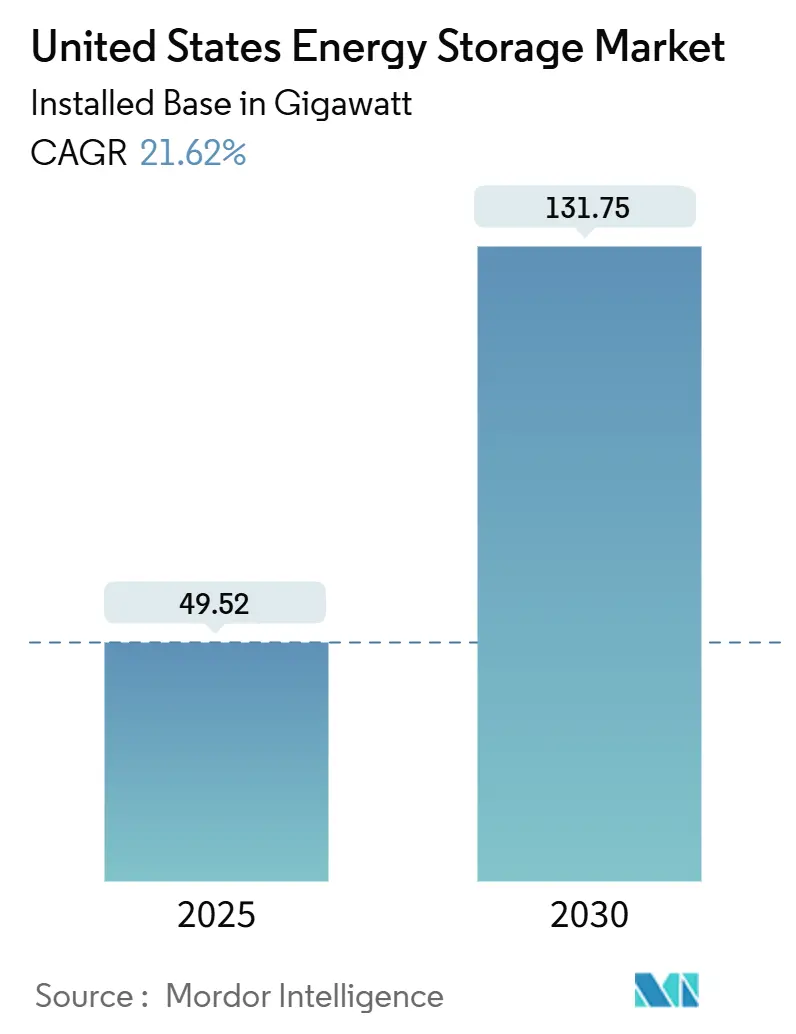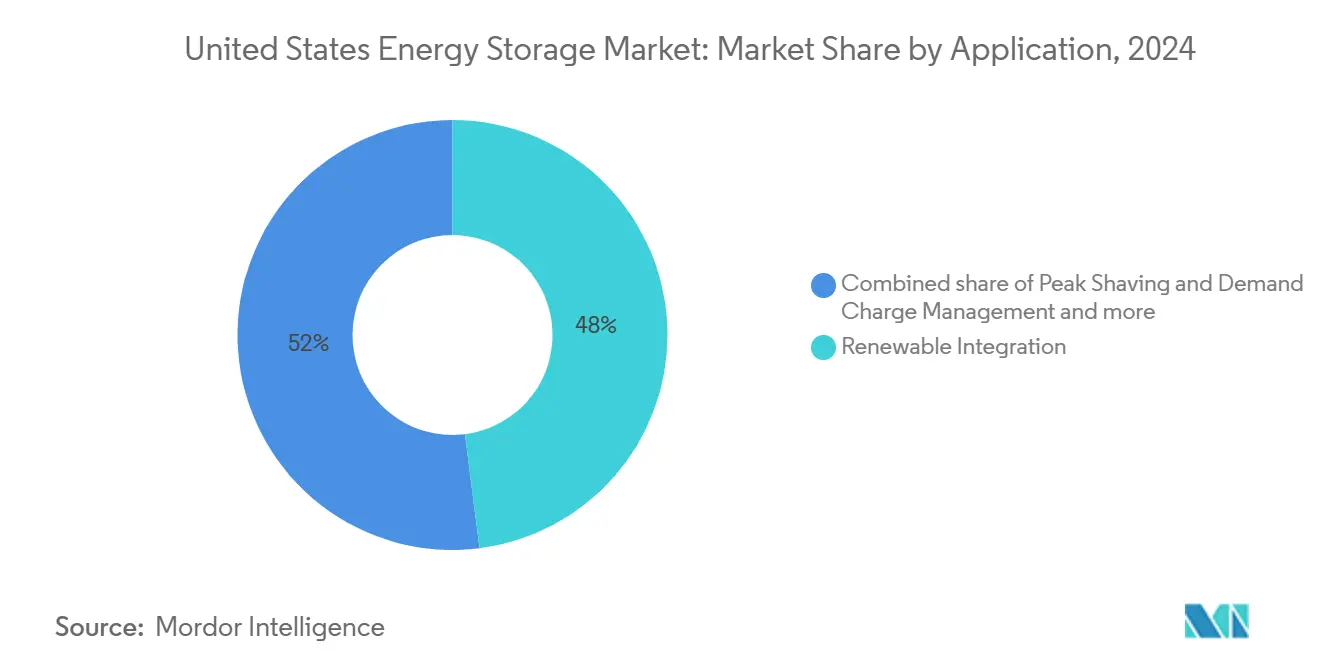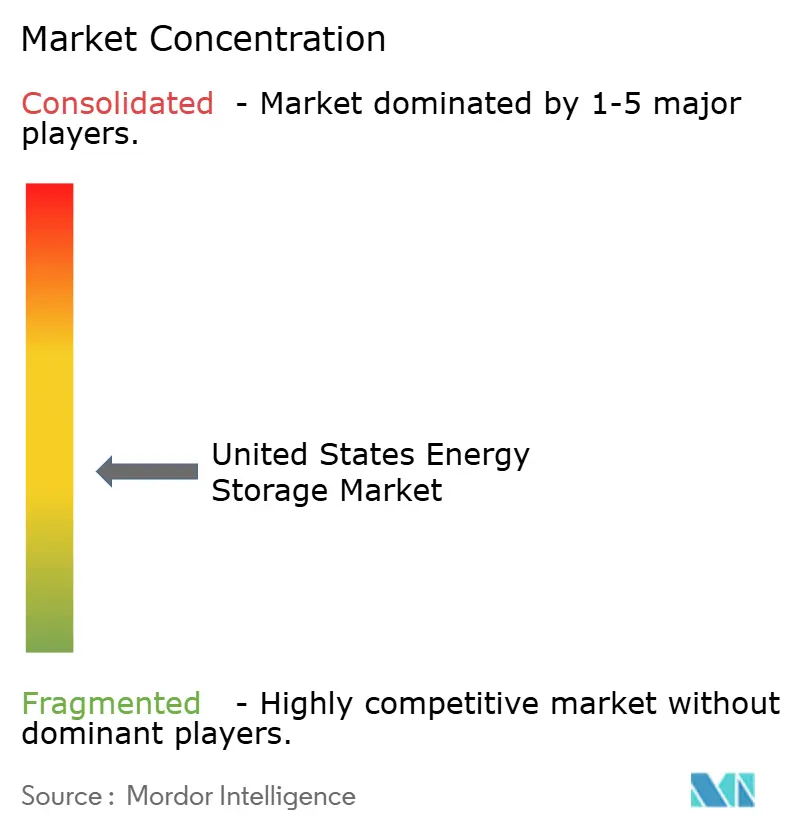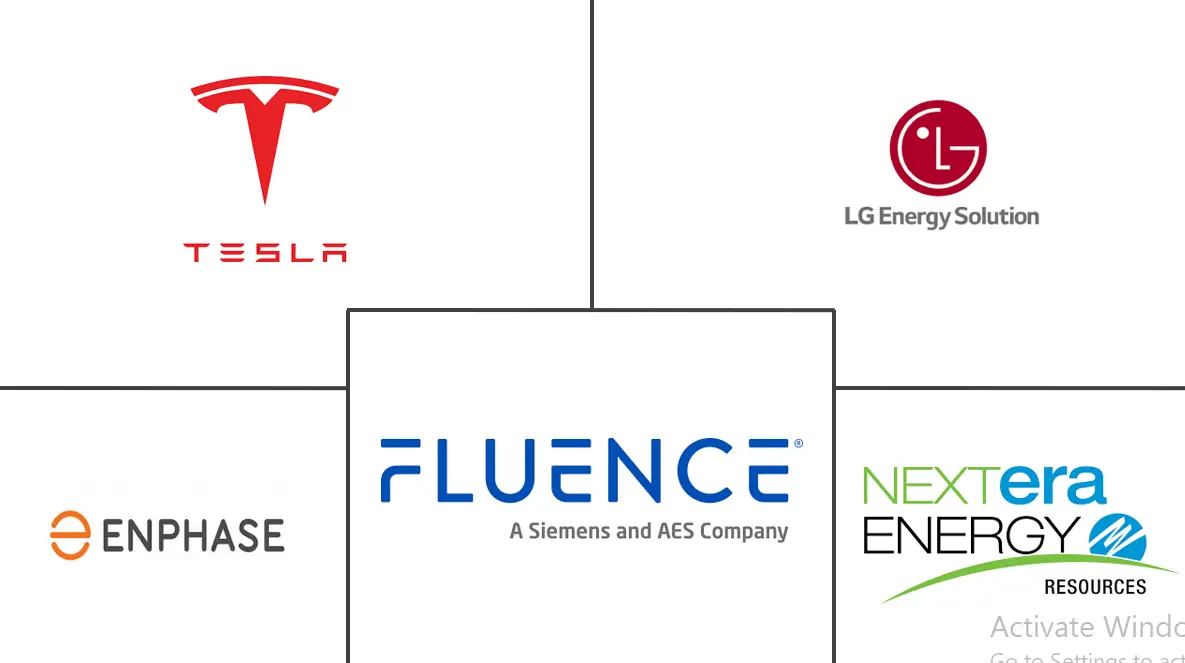
United States Energy Storage Market Analysis by Mordor Intelligence
The United States Energy Storage Market size in terms of installed base is expected to grow from 49.52 gigawatt in 2025 to 131.75 gigawatt by 2030, at a CAGR of 21.62% during the forecast period (2025-2030).
The 30% Investment Tax Credit is propelling the growth of the United States energy storage market, driven by the increasing adoption of standalone batteries, falling battery module prices, and the urgency to stabilize a grid coping with record renewable energy penetration.[1]U.S. Energy Information Administration, “Battery Storage Expected to Double by 2025,” eia.gov The Federal Energy Regulatory Commission (FERC) Orders 841 and 2222 further expand wholesale revenue opportunities for aggregated resources, while state rules, such as California’s NEM 3.0, accelerate behind-the-meter adoption. Cost declines stemming from the Inflation Reduction Act incentives on domestic cell production are broadening project economics. Concurrently, interconnection backlogs, PFAS-related safety compliance, and critical-mineral exposure to foreign processing reshape supply-chain risk profiles.
Key Report Takeaways
- By technology, batteries led with 82% of the United States energy storage market share in 2024, while hydrogen storage is projected to expand at a 28.5% CAGR through 2030.
- By capacity rating, 10–100 MWh systems accounted for a 38% share of the United States energy storage market size in 2024, whereas projects above 100 MWh are forecast to rise at a 36% CAGR to 2030.
- By 2024, front-of-the-meter deployments held a 73% share of the United States energy storage market; behind-the-meter assets, however, recorded the fastest 26% CAGR outlook.
- By application, renewable integration captured 48% of the United States energy storage market size in 2024, while backup power and resilience post the highest 32% CAGR to 2030.
- By end user, utilities dominated with a 72% share in 2024, whereas the residential segment is projected to advance at a 27% CAGR to 2030.
United States Energy Storage Market Trends and Insights
Drivers Impact Analysis
| Driver | (~) % Impact on CAGR Forecast | Geographic Relevance | Impact Timeline |
|---|---|---|---|
| Federal Investment Tax Credit extension | +4.20% | National; strongest in CA, AZ, HI | Medium term (2-4 years) |
| FERC Orders 841/2222 open wholesale markets | +3.80% | PJM, CAISO, ERCOT, MISO, ISO-NE | Long term (≥ 4 years) |
| California Rule 21 & NEM 3.0 policies | +2.50% | California | Medium term (2-4 years) |
| Solar-plus-storage growth in ERCOT & WECC | +3.90% | TX, CA, AZ | Medium term (2-4 years) |
| IRA manufacturing tax credits | +4.1% | National | Long term (≥ 4 years) |
| Utility IRPs adding long-duration storage | +3.1% | PJM, MISO, Southeast | Long term (≥ 4 years) |
| Source: Mordor Intelligence | |||
Federal Investment Tax Credit Extension Boosting Residential Storage Demand
The 30% credit available through 2032 has lowered average residential payback periods by 2.7 years, saving households roughly USD 6,000 per system. Transferability clauses now allow developers to monetize credits directly, unlocking new financing models. Residential project pipelines rose sharply in 2025, though proposed federal rollbacks threaten 300,000 clean-energy jobs if enacted. California, Arizona, and Hawaii exhibit the highest uptake due to high retail rates and concerns about outages. Supply-chain ramp-up keeps hardware prices in check, sustaining consumer interest despite policy uncertainty.
FERC Order 841/2222 Accelerating Wholesale-Market Participation of Storage
Order 841 mandates RTO/ISO tariff revisions, allowing storage to bid on all energy, capacity, and ancillary products, while Order 2222 permits aggregators to pool sub-100 kW assets. Early adopters in PJM reported 30% higher returns by stacking frequency regulation with energy arbitrage. The implementation pace is uneven; MISO sought delays until 2025, creating region-specific market depth. New telemetry and metering rules resolve double-counting issues for distributed fleets. Over time, wholesale access should rationalize distributed investment beyond incentive-driven programs.
California Rule 21 & NEM 3.0 Driving Behind-the-Meter Deployments
NEM 3.0 trims export compensation by 75%, prompting 60% of new solar installs to add batteries despite 17% higher combined system costs.[2]Lawrence Berkeley National Laboratory, “Residential Solar-Plus-Storage Economics Post NEM 3.0,” lbl.gov Rule 21 smart-inverter mandates open revenue opportunities for future grid-support services. Commercial customers leverage batteries for demand-charge reduction, while residential users focus on self-consumption. Job losses in solar installation hint at transitional pain, yet storage integrators see record orders. The state’s dynamic tariffs reward flexible loads, further aligning storage with profitability.
Solar-plus-Storage Pipeline Growth Across ERCOT and WECC
Co-located hybrid projects account for 60% of the 2025 additions, minimizing interconnection expenses and land use. ERCOT developers plan to install 20.4 GW of solar and 5.3 GW of wind by 2025, with much of it hybridized to capture peak pricing volatility. WECC states benefit from the correlation between abundant land and solar resources. Hybrid assets secure premium PPAs by firming renewable output. Queue delays averaging five years prompt developers to target substations with existing capacity; however, ongoing reforms aim to reduce clearance times.
Restraints Impact Analysis
| Restraint | (~) % Impact on CAGR Forecast | Geographic Relevance | Impact Timeline |
|---|---|---|---|
| Interconnection queue congestion | -2.80% | PJM, MISO, CAISO, NYISO | Medium term (2-4 years) |
| PFAS safety concerns in Li-ion cells | -1.90% | National; tighter in urban areas | Short term (≤ 2 years) |
| Uneven state-level incentives | -1.3% | Non-incentive states | Medium term (2-4 years) |
| Critical-mineral supply-chain exposure | -2.1% | National | Long term (≥ 4 years) |
| Source: Mordor Intelligence | |||
Interconnection Queue Congestion Delaying Large-Scale Projects
Applications ballooned to 2,600 GW, nearly double the current U.S. generation, and extended average approval timelines to nearly five years. Rising network upgrade cost assignments, sometimes 100% higher for storage versus fossil fuel assets, jeopardize project finance. FERC’s transition to a “first-come, first-served” cluster process aims to clear backlogs; however, execution lags behind applicant inflow. Developers pivot to behind-the-meter and microgrid models, fragmenting capacity additions. Persistent congestion could lead to capital shifting toward regions with streamlined interconnection policies.
PFAS Li-ion Electrolyte Safety Concerns Triggering Stricter Fire Codes
The detection of fluorinated compounds after thermal-runaway events spurred revisions to UL 9540A (ed5: 2025), which removed insulating layers during fire tests.[3] UL Solutions, “UL 9540A ed5: 2025 Overview,” ul.com NFPA 855-based local ordinances now impose tighter setback and ventilation rules, raising project soft costs. Some jurisdictions ban indoor systems above 20 kWh without special permits, curbing multi-family deployments. Research conducted by the University of Chicago into PFAS-free solvents demonstrates promising performance, but commercialization timelines remain uncertain. Integrators diversify chemistries toward LFP and zinc hybrids to navigate evolving codes.
Segment Analysis
By Technology: Battery Dominance Amid Emerging Alternatives
Lithium-ion batteries accounted for 82% of 2024 deployments, solidifying their role as the backbone of the United States' energy storage market. The cost drops below USD 300 per kWh, and cycle lives exceeding 5,000 cycles reinforce their suitability across various duration bands. LFP rapidly displaces NMC within the chemistry mix, favored for lower cobalt intensity and improved thermal stability. The United States' energy storage market size for hydrogen systems is forecast to grow at a 28.5% CAGR through 2030, primarily targeting seasonal shifts and decarbonization in heavy industry. Flow batteries gain consideration in RTO capacity solicitations seeking 6–12-hour resiliency.
Competitive pressure accelerates technology innovation. PFAS-free electrolyte research adds momentum to post-lithium chemistries, while DOE funding supports iron-air and zinc hybrid pilots. Pumped hydro's legacy 22 GW base anchors inertia resources, although licensing complexity dissuades new builds. Compressed air and flywheels remain niche, serving high-cycling ancillary applications. Overall, the United States energy storage market will likely continue to prioritize batteries while expanding its technology portfolio to hedge against safety, cost, and duration risks.

Note: Segment shares of all individual segments available upon report purchase
By Capacity Rating: Rising Scale Transforms Economics
Mid-sized arrays with a capacity of 10–100 MWh commanded 38% of deployments in 2024, valued for their flexible siting and standard, containerized designs. Developers leverage modular blocks to tailor output without bespoke engineering, containing balance-of-plant costs. The United States energy storage market share of assets exceeding 100 MWh is poised to rise fastest at a projected 36% CAGR. Falling cell prices and enhanced revenue stacking make gigawatt-hour-scale parks such as Moss Landing economically attractive. Capital-light software optimizes charge cycles to shield warranties.
Smaller sub-10 MWh systems continue to prevail in the residential and small commercial segments, facilitated by streamlined permitting and panel-level storage inverters. Enhanced AI dispatch orchestrates fleets into virtual power plants that clear wholesale bids. Long-range cost curves published by NREL suggest another 18–52% capital expenditure (Capex) drop by 2035, giving large projects cost leadership. As capacity classes converge on cost parity per kWh, locational grid constraints rather than hardware economics will drive decisions on sizing.
By Installation: Utility-Scale Front-of-Meter Holds Majority
With 73% of installed power in 2024, front-of-meter projects remain the linchpin of grid-stability planning. Utilities secure regulatory approval to place assets in the rate base or enter multi-year tolling agreements, creating predictable revenue. The United States energy storage market size in the front-of-meter arena benefits from a 40% lower cost per kWh compared to comparable customer-sited systems. Wholesale market participation rights under FERC Orders encourage merchant investors to finance energy-only projects in ERCOT, where scarcity pricing spikes can quickly recoup capital.
Behind-the-meter growth, however, outpaces the market at a 26% annual rate, driven by consumer preferences for resilience and adverse net-metering revisions. Aggregators pool residential batteries into VPPs that bid for frequency regulation, spreading fixed costs across thousands of homes. Software-centric firms monetize dispatch value, signaling an evolving competitive battleground. As grid services become commoditized, the distinction between front and behind-the-meter services will hinge on interconnection constraints and policy incentives.
By Application: Renewable-Integration Leads, Resilience Accelerates
Storage dedicated to smoothing wind and solar variability accounted for 48% of 2024 capacity, reflecting the imperative to meet renewable portfolio standards without compromising reliability. Locational marginal price volatility, including negative midday prices, underpins arbitrage economics. The United States energy storage market size for backup and resilience activities is currently trailing, but is projected to post a 32% CAGR. Hurricanes, wildfires, and polar vortex events expose grid fragility, prompting critical-facility operators to add 8-hour batteries or microgrids.
Demand-charge management remains relevant, especially in commercial sectors where charges account for up to 70% of bills. Frequency regulation shrinks as a share, yet remains lucrative when stacked with other services. The Department of Energy’s push for multi-day long-duration storage underscores an industry pivot toward deeper decarbonization needs.

Note: Segment shares of all individual segments available upon report purchase
By End User: Utility Dominance with Residential Upswing
Utilities held 72% of installations in 2024, leveraging their scale to provide capacity, defer transmission costs, and hedge procurement costs. State regulators are increasingly approving cost recovery for battery investments, treating them similarly to traditional generation. The United States energy storage industry sees residential uptake accelerating at a 27% CAGR, spurred by falling component prices and a cultural shift toward energy independence. Federal tax credits and high-profile outages in California and Texas fuel homeowner interest.
Commercial and industrial customers occupy the middle ground, integrating batteries for demand management, process continuity, and, increasingly, EV-charger peak shaving. Cross-sector synergies emerge as vehicle-to-grid pilots test bidirectional charging revenue streams. End-user diversification mitigates revenue volatility, broadening the foundation of the United States energy storage market.
Geography Analysis
California led with 7.3 GW online in 2024, leveraging aggressive renewables mandates and sophisticated market products that reward flexible capacity. Revenue pressure emerged in 2024 when oversupply reduced merchant earnings by 35%, prompting project developers to prioritize nodes with local capacity benefits. Texas followed at 3.2 GW, deriving growth from ERCOT’s energy-only market, which produced triple-digit scarcity prices during heatwaves that incentivize fast-responding assets.
The Northeast, covering PJM, NYISO, and ISO-NE, is gaining momentum as states set storage procurement targets. New York’s 6 GW by 2030 and New Jersey’s 2 GW goals shape predictable pipelines, although dense-urban interconnection queues extend timelines beyond five years. Arizona and the broader Southwest expect a fourfold increase in capacity to 3.6 GW as utilities address solar-driven evening shortfalls. Transmission constraints nationally influence siting more than policy alone: DOE’s Interconnection Roadmap seeks to streamline 12,000 pending renewable and storage projects.
Midwest utilities in MISO integrate eight-hour systems to backfill retiring coal plants, while Southeast vertically integrated utilities embed storage in rate-regulated resource plans. Non-lithium long-duration demonstrations receive over USD 270 million from the California Energy Commission, illustrating a nationwide push to diversify storage chemistries. Across all regions, market designers increasingly value duration and locational flexibility, reshaping power-purchase contract structures.
Competitive Landscape
Utility-scale supply is moderately concentrated, with Tesla, Fluence, and NextEra Energy controlling significant pipelines. Tesla's integrated cell-to-software stack gives cost and performance advantages that resonate across utility and residential segments. Fluence partnered with a domestic contract manufacturer in 2024 to secure IRA content eligibility and reduce logistics risk. NextEra leverages its renewable fleet, managing 3 GW of storage assets co-located with solar and wind to maximize capacity accreditation.
New entrants, from automotive to data-center sectors, heighten rivalry. Ford and General Motors explore stationary applications for second-life packs, while Amazon Web Services pilots on-site batteries to optimize energy bills. White-space innovation centers on long-duration technologies: Form Energy's iron-air chemistry targets 100-hour discharge at a lower cost than lithium, and ESS Inc.'s iron-flow design scales modularly. Software differentiation sharpens, with AI dispatch platforms from Stem, Inc. and Wärtsilä vying to monetize multi-service stacking. M&A accelerated in 2024 as private equity funds sought platform investments, signaling confidence in stable cash flows.
Interconnection backlogs shape competitive strategy. Developers with secured queue positions command premiums in asset trades. The supply chain also differentiates players: companies with North American cathode plants insulate projects from geopolitical risk and uncertainty related to the Inflation Reduction Act's domestic-content bonus. Safety compliance competence, particularly in relation to UL 9540A ed5 testing, becomes another market gate, favoring incumbents with dedicated engineering teams.
United States Energy Storage Industry Leaders
-
Tesla Inc.
-
Fluence Energy LLC
-
LG Energy Solution Ltd.
-
NextEra Energy Resources
-
Enphase Energy Inc.
- *Disclaimer: Major Players sorted in no particular order

Recent Industry Developments
- May 2025: ENGIE and CBRE partnered to develop a 2.4 GW battery portfolio focused on real-estate-adjacent sites.
- March 2025: Diversified Energy, FuelCell Energy, and TESIAC formed an acquisition vehicle targeting 360 MW of net-zero power, including storage, for data centers in Appalachia.
- March 2025: UL Solutions issued UL 9540A ed5: 2025, which includes major changes to the thermal-runaway protocol.
- February 2025: Tesla surpassed Sungrow as the top global battery producer, reinforcing vertical integration advantages.
Research Methodology Framework and Report Scope
Market Definitions and Key Coverage
Our study defines the United States energy storage market as the installed base and yearly additions of grid-connected and behind-the-meter systems that absorb electricity and discharge it on demand, including battery chemistries (Li-ion, lead-acid, flow, Na-S), pumped-hydro, compressed-air, flywheels, thermal storage, and power-to-hydrogen assets. Capacity is expressed in gigawatts of rated power; value calculations apply technology-specific average system costs.
Scope Exclusions: Mobile traction batteries, fuel-cell stacks used solely for mobility, and pure software dispatch services are kept outside the market boundary.
Segmentation Overview
- By Technology
- Batteries (Lithium-ion, Lead-acid, Flow Batteries, Sodium-sulfur and Others)
- Pumped Hydro Storage
- Compressed Air Energy Storage
- Flywheel Storage
- Thermal Energy Storage
- Hydrogen Energy Storage
- By Capacity Rating
- Below 1 MWh
- 1 to 10 MWh
- 10 to 100 MWh
- Above 100 MWh
- By Installation
- Front-of-the-Meter
- Behind-the-Meter
- By Application
- Renewable Integration
- Peak Shaving and Demand Charge Management
- Frequency Regulation
- Backup Power/Resilience
- By End User
- Residential
- Commercial and Industrial
- Utility
Detailed Research Methodology and Data Validation
Primary Research
Mordor analysts interviewed utility planners in California, Texas, and New York, EPC contractors building front-of-the-meter projects, residential solar-plus-storage installers, and component vendors across the Midwest. These conversations validated queue-conversion assumptions, real-world balance-of-system costs, and policy uptake rates, filling gaps that desk research alone could not bridge.
Desk Research
We began with publicly available, high-reliability datasets such as EIA Form 860/861, FERC Electric Quarterly Reports, DOE's Storage Futures Study, NREL price trackers, and American Clean Power's Storage Monitor. Trade association briefs, state PUC filings, patent trends from Questel, and federal incentive updates rounded out policy and cost inputs. Company 10-Ks, investor decks, and project press releases were scraped, while D&B Hoovers supplied revenue breakouts for key integrators and cell makers.
News aggregation from Dow Jones Factiva and peer-reviewed work in journals like Joule provided price-learning rates, safety recall statistics, and cycle-life benchmarks. The sources cited above illustrate the breadth of secondary material; many additional references were consulted for data corroboration and clarification.
Market-Sizing & Forecasting
A top-down model starts with historical installed capacity from EIA, applies forecast additions drawn from interconnection queues, and layers average $/kW costs to derive value. Results are cross-checked through selective bottom-up roll-ups of vendor shipments and sampled ASP × volume estimates. Key variables include average four-hour system cost declines, ITC step-down timelines, state storage mandates, residential solar attachment rates, and capacity-weighted utilization factors. Multivariate regression, supported by expert consensus, projects each driver to 2030; scenario analysis captures policy or materials-price shocks. Gap handling uses normalized cost curves where bottom-up data are thin.
Data Validation & Update Cycle
Outputs pass variance checks against ACP quarterly tallies and DOE price indices, followed by peer review and senior analyst sign-off. Our models refresh every 12 months, with interim revisions triggered by policy rulings or >10% cost swings.
Why Mordor's United States Energy Storage Baseline Commands Confidence
Published estimates differ because firms mix revenue and capacity units, select unequal technology baskets, and apply divergent system-price learning curves. By anchoring figures to verified EIA capacity data and current ITC rules, Mordor captures the market reality decision-makers budget against.
The largest gaps arise when others fold EV batteries into the total, assume blanket eight-hour durations, freeze price trajectories, or extend forecasts without refreshing project pipelines. Our annual refresh and dual-unit reporting avoid these pitfalls.
Benchmark comparison
| Market Size | Anonymized source | Primary gap driver |
|---|---|---|
| 49.52 GW installed base (2025) | Mordor Intelligence | - |
| USD 106.7 bn (2024) | Global Consultancy A | Combines revenue and capacity, includes EV traction packs, no price-learning adjustment |
| USD 138.6 bn (2025) | Industry Data Firm B | Assumes universal eight-hour duration and utility-only scope |
| USD 3.62 bn (2025) | Research Group C | Tracks standalone BESS revenue only, excludes pumped-hydro and hydrogen storage |
In sum, Mordor's disciplined scope selection, dual top-down/bottom-up cross-checks, and timed refresh cadence yield a balanced, transparent baseline that clients can retrace and replicate with confidence.
Key Questions Answered in the Report
What is the projected size of the United States energy storage market by 2030?
The market is expected to reach 131.75 GW of installed capacity by 2030, growing at a 21.62% CAGR.
Which technology segment is expanding fastest in the United States energy storage market?
Hydrogen storage shows the highest growth, with a projected 28.5% CAGR between 2025 and 2030.
How does the Investment Tax Credit influence residential storage economics?
The 30% credit reduces average payback periods by 2.7 years and lowers upfront costs by roughly USD 6,000 per home system.
Why are interconnection queues a restraint for large-scale battery projects?
More than 2,600 GW of capacity awaits grid connection, extending approval timelines to almost five years and inflating network-upgrade costs.
What role do long-duration storage technologies play in utility planning?
Utilities increasingly include 8-10-hour systems in resource plans to replace retiring coal plants and ensure reliability during renewable lulls, supported by federal pilot funding.
Page last updated on:



